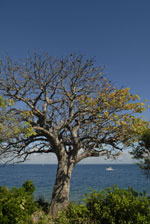|
|
Moutain Zebra National Park
Northern Cape South Africa
In every season, Camdeboo National Park is beautiful.
But as with most places, this semi-desert park is spectacular in spring
colours. The coral aloe strews the mountainous Karoo veld with joyous
orange. In fact, after good rains, there are flowers everywhere –
Karoo violets, pink; yellow and white vygies; the dense canopies of the
witgat trees with their pale green blooms.
Valley of Desolation
Almost all visitors to the Karoo, even the regulars, come to pay homage
to the Valley of Desolation – the ‘Cathedral of the Mountains’.
It is a beautiful geology lesson, a cupped hollow surrounded by towering
columns of jointed dolerite rocks. Pillars of the earth over which kestrels
fly. Visitors chatter as they arrive, but often fall into meditative silence
as they sit on the flat rocks along the viewpoint edges.
Camdeboo National Park began small in 1935 when the
Valley of Desolation was proclaimed a National Monument. Then, in 1974,
businessman Dr Anton Rupert – one of Graaff-Reinet’s most
famous sons – suggested the idea of a Karoo Nature Park with the
Valley at its core. Through the South African Nature Foundation, a campaign
was launched to raise funds, and schoolchildren were able to buy a symbolic
piece of the proposed park that was previously town commonage. Over 300
000 children responded, so funding the initial 2 698 hectare reserve.
Giant Hands
Over the years, the reserve was gradually expanded until it almost surrounded
the town. In fact, on a map it looks like two gigantic cupped hands, with
Graaff-Reinet at the centre.
Green Hollow
The national park, proclaimed in 2005, is South Africa’s newest.
It is named in remembrance of the Inqua tribe who lived on this land in
1600s; grazing their fat-tailed sheep and cattle on the plains. They called
it the Camdeboo, which means ‘green hollow’.It now stretches
over 14 500 hectares, and incorporates the large Nqweba dam. Set in the
Karoo’s mountainous sub-desert, the park has important conservation
value as it protects three rather special forms of vegetation –
shrubland, dwarf shrubland and succulent thicket
South African National Parks have an exciting goal in mind – to
enter into conservation partnerships with landowners until Camdeboo meets
up with the Mountain Zebra National Park. This would create a massive
conservation area stretching 120 km in length, and covering at least 330
000 hectares. This kind of mega-park is highly valuable in terms of biodiversity
protection.
What You Can See
Because the park is so new, there are few fences. You’re more likely
to be enchanted by the scenery, or spend an hour watching a meerkat colony
digging for scorpions and beetle grubs, than looking for big game. But
there are buffalo, and Cape mountain zebra. And being down on the plains
at the end of a day is very special. You’ll see kudu, horns thrown
back, threading their long-legged way down the hills through the succulent
spekboom and a herd of black wildebeest may suddenly start skipping about
like young lambs for no particular reason. And you may have a moment with
a scrub hare, nibbling on grasses in a small clearing, or be lucky enough
to see a bat-eared fox emerge sleepily from its den, ready for a night’s
insect hunting.
Twitching
Of the birds, the most recognisable is the ostrich, well adapted
to life in the dry shrublands. Also fairly common in the game watching
areas are the pale chanting goshawks, along with the neddicky, long-billed
crombec, titbabbler, rock kestrel, brownhooded kingfisher and anteating
chat.On FootThis is an ideal park for walking. You could try the Crag
Lizard Trail, an easy option that loops for 45 minutes around the Valley
viewpoints.Otherwise try the Eerstefontein Day Walk, which has route options
of 5, 11 and 14 kilometres, all in the shadow of the unmistakable Spandaukop
hill.There’s also the Driekoppe overnight trail in the park’s
remote eastern sector – but bring jackets in winter as it often
snows there.
Accommodation
Apart from a hiker’s overnight hut, there is no accommodation in
the park. But Graaff-Reinet, a picturesque historical town with excellent
museums and distinctive architecture, has plenty.
|



